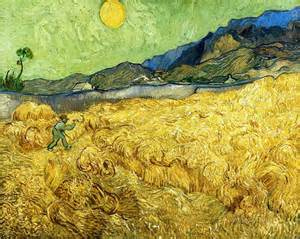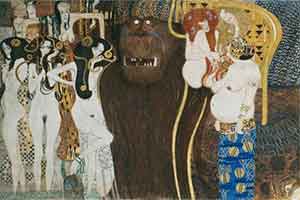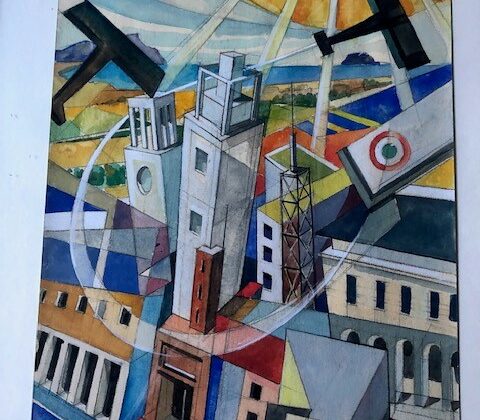Van Gogh Exhibition in Milan
by Prof. Francesco Carelli
University of Milan and Rome
The first major exhibition devoted to Van Gogh opened at Palazzo Reale in Milan on 23 February 1952. The public was wild with excitement, as reported in the press at the time.
After 62 years the works of one of the most famous artists in the world are returning to Palazzo Reale for the ʻVan Goghʼ exhibition promoted by the Milan City Council – Culture and produced and organized by Arthemisia Group and 24 ORE Cultura – Gruppo 24 ORE.
The exhibition offers a completely new take on Van Gogh and focuses on themes linked to Milan Expo
2015: the earth and its fruits; man as the centre of the real world; rural and agricultural life closely linked to the cycle of seasons.
At a time when most artists, such as the Neo-Impressionists Seurat and Signac, were turning their gaze to the urban landscape that was a product of European industrialization at the end of the 19th century, Van Gogh shifted his attention to the rural landscape and the peasant world. The artist believed that the simple life of the country was a subject with a lofty and sacred quality, and made those who worked the land heroic, noble figures.
Traditional rural life and tasks provided the material for his research: from the first drawings made in
Holland to the last masterworks painted near Arles, Van Gogh expressed his affinity with the humble,
identifying with them and representing their dignified nature.
The curatorial work has enabled the construction of an itinerary that guides the visitor through more than 50 artworks, some famous and others on public display for the first time. The viewer will be able to explore and grasp the complex relationship between man and nature, toil and beauty, and relive the many moods that Vincent Van Gogh indelibly transposed into the works he created.
Wheat as a subject
Failing to find a vocation in ministry, Van Gogh turned to art as a mean to express and communicate his deepest sense of the meaning of life. Cliff Edwards, author of “Van Gogh and God: A Creative Spiritual Quest” wrote: “Vincent’s life was a quest for unification, a search for how to integrate the ideas of religion, art, literature, and nature that motivated him.”
Van Gogh came to view painting as a calling, “I feel a certain indebtedness [to the world] and… out of gratitude, want to leave some souvenir in the shape of drawings or pictures — not made to please a certain taste in art, but to express a sincere feeling.” When Van Gogh left Paris for Arles, he sought an antidote to the ills of city life and work among laborers in the field “giving his art and life the value he recognized in rural toil.” In the series of paintings about wheat fields, Van Gogh expresses through symbolism and use of color his deeply felt spiritual beliefs, appreciation of manual laborers and connection to nature.
Spiritual significance
As a young man Van Gogh pursued what he saw as a religious calling, wanting to minister to working people. In 1876 he was assigned a post in Isleworth, England to teach Bibleclasses and occasionally preach in the Methodist church.
When he returned to the Netherlands he studied for the ministry and also for lay ministry or missionary work without finishing either field of study. With support from his father, Van Gogh went to Borinage in southern Belgium where he nursed and ministered to coal miners. There he obtained a six-month trial position for a small salary where he preached in an old dance hall and established and taught Bible school. His self-imposed zeal and asceticism cost him the position. After a nine-month period of withdrawal from society and family; he rejected the church establishment, yet found his personal vision of spirituality, “The best way to know God is to love many things. Love a friend, a wife, something – whatever you like – (and) you will be on the way to knowing more about Him; this is what I say to myself. But one must love with a lofty and serious intimate sympathy, with strength, with intelligence. By 1879, he made a shift in the direction of his life and found he could express his “love of God and man” through painting.
Drawn to Biblical parables, Van Gogh found wheat fields metaphors for humanity’s cycles of life, as both celebration of growth and realization of the susceptibility of nature’s powerful forces.
- Of the Biblical symbolism of sowing and reaping Van Gogh taught in his Bible lessons: “One does not expect to get from life what one has already learned it cannot give; rather, one begins to see more clearly that life is a kind of sowing time, and the harvest is not here.”
- The image of the sower came to Van Gogh in Biblical teachings from his childhood, such as:
“A sower went out to sow. As he sowed, some seed fell along the path, and the birds came and devoured it. Other seed fell on rocky ground, where it had not much soil, and immediately it sprang up, since it had no depth of soil; and when the sun rose it was scorched, and since it had no root it withered away. Other seed fell among thorns and the thorns grew up and choked it, and it yielded no grain. And other seeds fell into good soil and brought forth grain, growing up and increasing and yielding thirty fold, and sixty fold and a hundredfold.(Mark 4:3-8)
Van Gogh used the digger and ploughman as symbols of struggle to reach the kingdom of God. He was particularly enamored with “the good God sun” and called anyone who didn’t believe in the sun infidels. The painting of the haloed sun was a characteristic style seen in many of his paintings, representing the divine, in reference to the nimbus in Delacroix’sChrist Asleep During the Tempest.
Field workers
The “peasant genre” that greatly influenced Van Gogh began in the 1840s with the works of Jean-François Millet, Jules Breton, and others. In 1885 Van Gogh described the painting of peasants as the most essential contribution to modern art. He described the works of Millet and Breton of religious significance, “something on high,” and described them as the “voices of the wheat.”
Throughout Van Gogh’s adulthood he had an interest in serving others, especially manual workers. As a young man he served and ministered to coal miners which seemed to bring him close to his calling of being a missionary or minister to workers.
A common denominator in his favored authors and artists was sentimental treatment of the destitute and downtrodden. Referring to painting of peasants Van Gogh wrote to his brother Theo: “How shall I ever manage to paint what I love so much?” He held laborers up to a high standard of how dedicatedly he should approach painting, “One must undertake with confidence, with a certain assurance that one is doing a reasonable thing, like the farmer who drives his plow… (one who) drags the harrow behind himself. If one hasn’t a horse, one is one’s own horse.”
Connection to nature
Van Gogh used nature for inspiration, preferring that to abstract studies from imagination. He wrote that rather than making abstract studies: “I am getting well acquainted with nature. I exaggerate, sometime I make change in motif; but for all that, I do not invent the whole picture; on the contrary, I find it already in nature, only it must be disentangled.”
The close association of peasants and the cycles of nature particularly interested Van Gogh, such as the sowing of seeds, harvest and sheaves of wheat in the fields Van Gogh saw plowing, sowing and harvesting symbolic to man’s efforts to overwhelm the cycles of nature: “the sower and the wheat sheaf stood for eternity, and the reaper and his scythe for irrevocable death.” The dark hours conducive to germination and regeneration are depicted in The Sower and wheat fields at sunset.

-
In 1889 Van Gogh wrote of the way in which wheat was symbolic to him: “What can a person do when he thinks of all the things he cannot understand, but look at the fields of wheat… We, who live by bread, are we not ourselves very much like wheat… to be reaped when we are ripe. Van Gogh saw in his paintings of wheat fields an opportunity for people to find a sense of calm and meaning, offering more to suffering people than guessing at what they may learn “on the other side of life.” He writes Theo that he hopes that his family brings to him “what nature, clods of earth, the grass, yellow wheat, the peasant, are for me, in other words, that you find in your love for people something not only to work for, but to comfort and restore you when there is a need. Further exploring the connection between man and nature, he wrote his sister Wil, “What the germinating force is in a grain of wheat, love is in us.”
Color
Wheat fields provided a subject in which Van Gogh could experiment with color. Tired of his work in the Netherlands made with dull, gray colors, he sought to create work that was more creative and colorful– In Paris Van Gogh met leading French artists Edgar Degas, Georges Seurat and others who provided illuminating influences on the use of color and technique. His work, previously somber and dark, now “blazed with color.” His use of color was so dramatic that Van Gogh was sometimes called an Expressionist.
While he learned much about color and technique in Paris, southern France provided an opportunity to express his “surging emotions. Enlightened by the effects of the sun drenched countryside in southern France, Van Gogh reported that above all, his work “promises color.” This is where he began development of his masterpieces.
Van Gogh used complementary, contrasting colors to bring an intensity to his work, which evolved over the periods of his work. Two complementary colors of the same degree of vividness and contrast. He mentioned the liveliness and interplay of “a wedding of two complementary colors, their mingling and opposition, the mysterious vibrations of two kindred souls.” An example of use of complementary colors is The Sower where gold is contrasted to purple and blue with orange to intensify the impact of the work. The four seasonswere reflected in lime green and silver of spring, yellow when the wheat matured, beige and then burnished gold.
The main corpus of this show, like the 1952 exhibition, is composed of works from the Kröller-Müller
Museum in Otterlo. These are supplemented by artworks from the Van Gogh Museum in Amsterdam,Museo Soumaya-Fundación Carlos Slim in Mexico City, Centraal Museum in Utrecht and private collections that are usually inaccessible. Together they offer a unique opportunity to analyze in depth, through the artistʼs eyes.



